Text & Photographs : Manjira Majumdar
It is a lovely balmy day in Delhi and my family and I board the Shatabdi Express on a late February afternoon. The train journey prepares you for a somewhat laid back visit to a historic city; where the traffic can be chaotic in parts. Most of the time, however, the cab drivers assure you with, “tension na lo ji” (Please don’t get stressed).
The city is an old one. It is one that houses the most revered place of worship for the Sikhs – the Harmandir Sahib. In other words: the resplendent Golden Temple. However, the birthplace of the founder of Sikhism Guru Nanak is across the border, the district of Nankana Sahib, near Lahore. Sikhism represents a culture of seva and of strong values in keeping with a martial community.
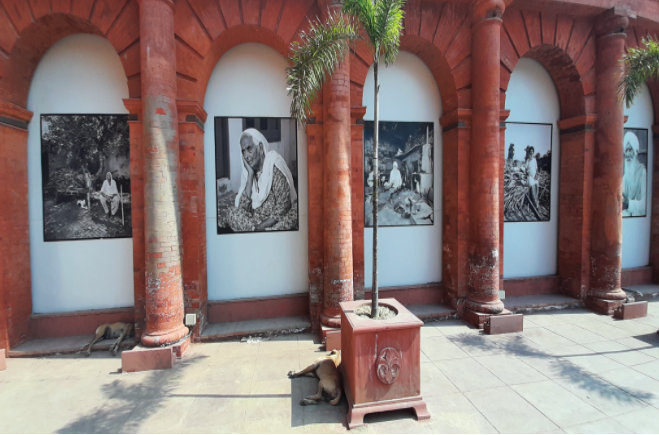
The twilight gradually disappears and merges with the twinkling lights of the quick halts along the way; namely, Ludhiana, Jalandhar and Beas, before finally stopping at Amritsar Junction. The city of Amritsar may lack the symmetrical modern architecture of Chandigarh or the aristocratic elegance of Patiala, but crumbling in parts, it stands as a strong bearer of a rich historic legacy. The temple complex sharing space with Jallianwallah Bagh on one side and the recently converted imposing Town Hall into Partition Museum on the other is joined by a paved area. This has been declared a heritage zone. No transport is allowed in here but shops in neat rows abound and spending a leisurely afternoon/evening here is an ideal thing to do in Amritsar.
The second thing to do and enjoy in Amritsar is taste its local cuisine. Roasted chicken which is tandoori chicken by another name, different types of bread – naan, kulcha, paratha, lassi, tarka dal and fiery pickles are the lip smacking fare that are tasty, wholesome and robust. Green chillies, tomatoes and whole lentils dominate.
The Temple halva, prepared fully in ghee, is first offered as prasad, and then a bit of it partaken by visitors, is simply divine. The langar lunch, after the darshan of the inner sanctum sanctorum, comprises roti, sabji, dal, kheer and lassi. The city offers more gastronomical delights, of which later…
Heritage complex at dusk
If the mornings are best for a visit to the Golden Temple complex which houses the Akal Takth, which is one of the five seats of power of the Sikhs, and the holy water body, keep up the continuity with an evening visit as well. Morning is the best time to visit the inner chamber for a view of the Guru Granth Sahib followed by langar (open 24×7), but the evening is mesmerising. After our moring visit and lunch, it is time for us to go back to the hotel for a quick rest, especially for those tired feet after walking around and standing in queues.
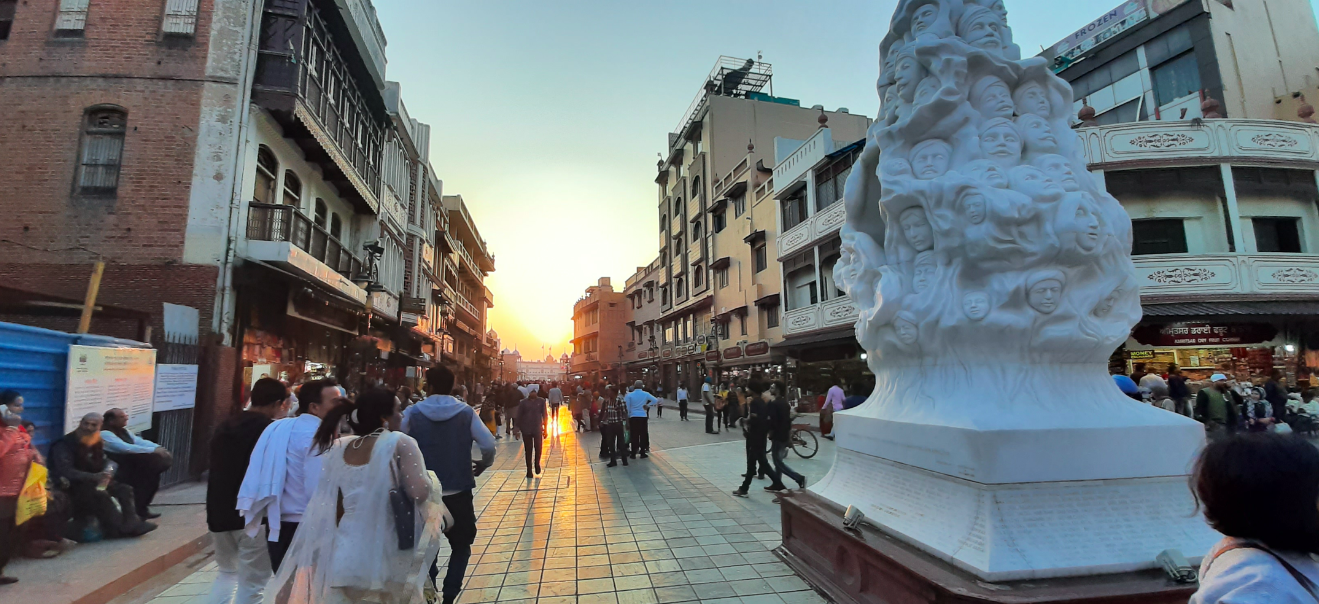
But before returning, during the day, do try to squeeze in a visit to the adjacent Jallianwala Bagh memorial as well. It brings a slice of our oppressive history alive. The massacre that occurred at the behest of General Dyer, a temporary general of the British Army, led to country wide protests. Ultimately, it all culminated in the call of “Swaraj is my birthright and I shall have it” from Bal Gangadhar Tilak.
At dusk, a sense of calmness returns to the heritage complex. The whole complex comes into focus as it gets gradually illuminated and a hushed sense of serenity prevails. It is still February and though it is not so cold as was expected, a gentle breeze blows to create a magical spell of happiness. The dazzling golden domes of the day, lit by sunlight, now stand out as a glittering bejeweled pendant. The background of soft lights is strung together like a necklace. It is as if the area has gone through a transformation in just few hours.
The paved heritage arcade takes a life of its own. The religious centres reverberate with sounds of kirtan and strains of aarti from a nearby temple. There is a buzz of human voices matched with sounds of footfall but the morning frenzy has evaporated. Bargain hunters can now trawl the market not for scarves to tie around the head as a mark of respect, but for those beautifully embroidered phulkari dupatta in a range of quality, bangles and jhumka on round hoops. These are displayed at the sidewalk kiosks and bigger shops. So is the typical footwear or embroidered jutti. Modern shops and boutiques with mannequins displayed at the entrance beckon passers by.
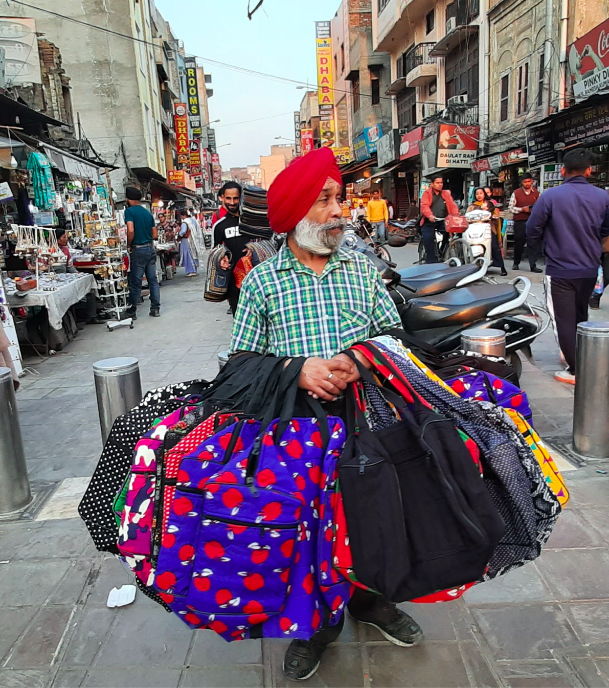
This is the time to observe life and people of the city. Though crowded with tourists, one can notice the young local men and women. The young men who do not don turbans, sport a variety of hairstyles – punk, Mohawk. Tik Tok videos are being shot at street corners and like scenes in many of our cities, modernity and tradition collide. McDonald’s co-exist with Pappi di Hatti! Traditional wedding collections edge out the modern silhouettes modelled by mannequins.
The other typical shops have on offer little candy sized aam papad, chicken and chole masala and little knick-knacks to carry back home as souvenirs. But it is time to explore the gastronomical delights.
Chaat, tea and roasted chicken
An evening snack of papdi chaat, the dahi and mint chutney sweetened with jaggery at Brijwasi’s, followed by sweetened but invigorating cup of masala tea at Giani’s, both joints located near INA Colony, has us craving for more food. We are directed to Beera Chicken House on Basant Road for an array of kebabs. Giani’s also acts as a stop for those hungry looking for a quick snack. The omelette and toast are good accompaniments to the tea.
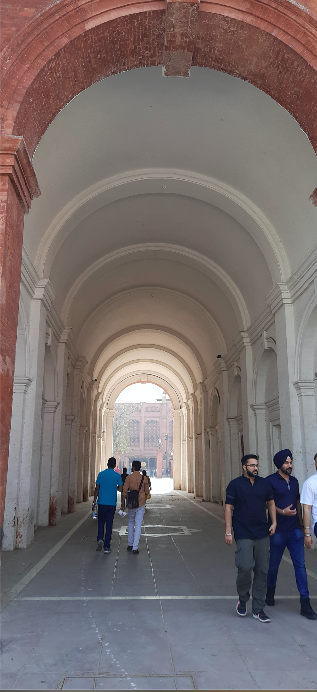
For dinner, we know we are somewhere near Beera’s, by the aroma of grilled meats. The roasted chicken here is the piece de resistance, though the sheekh kebab, keema naan and fish tikka are to die for.
Now the roast chicken is somewhat like tandoori chicken in that it is grilled but with some secret marinade that makes it smoky, juicy; the big succulent pieces so soft that they fall off the bone as it were. We are so full enjoying this chicken that we give the chaap and other delicacies a miss this time. In fact we take the e-rickshaw back to the hotel to enjoy some fresh breeze. A very satisfying first day indeed!
Partition Museum
Day two is earmarked for the Partition Museum. The sun beats down gently but the weather is turning; it is getting warmer. We just move around the city, soaking in its ambience. Like in most cities, old structures are giving way to newer ones.
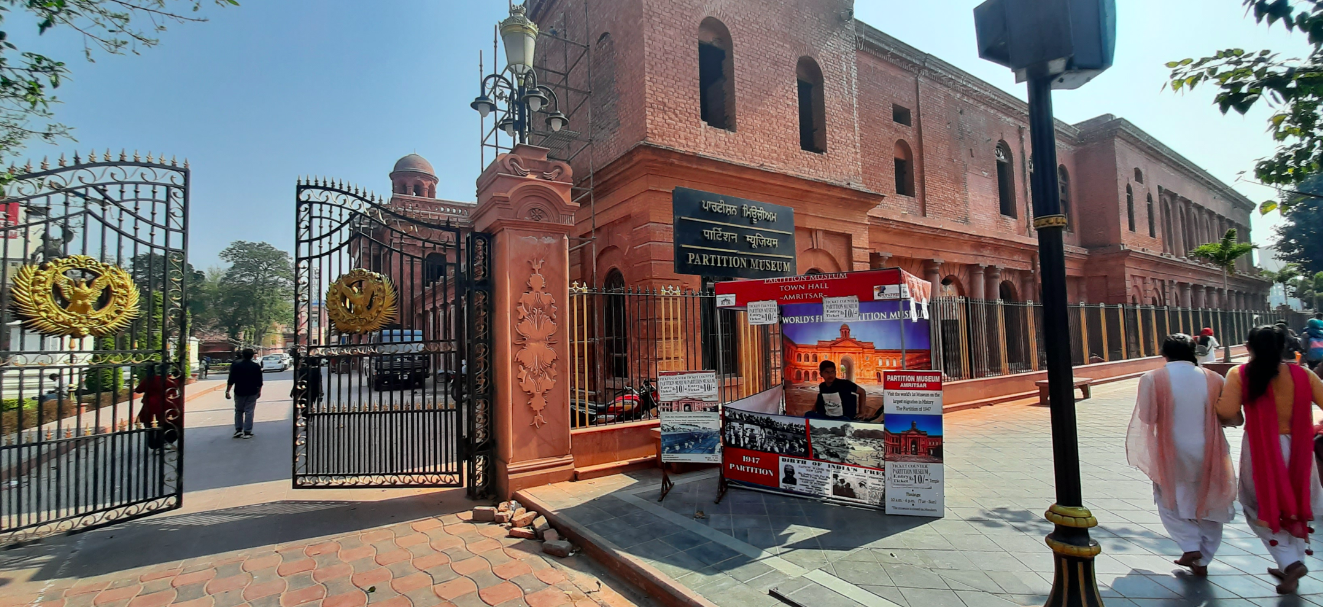
Though some parts are dilapidated, with diesel smoke emanating from old vehicles, there are enough sites of history to remind you of the heritage of the city. The statue of Maharaja Ranjit Singh atop a horse is the most impressive. One can make a quick trip to the Durgiana Mandir of the Hindus modelled along the lines of the Golden Temple. But the overriding images in Amritsar are of Sikhs and Sikhism.
After the hotel breakfast, we hail a cab and go to the area which is again very close to the temple complex. The imposing Town Hall which some said was a public library once while others that it was a court for lower cases stands grandly with its imposing gates. We decide to spend a good part of the morning at the museum, which is open on all days, except on Mondays.
Open to the public since August 2017, the museum is still evolving and open to donations, artefacts such as personal belongings, letters and other materials as much as personal narratives. Housed in the stately brick coloured building that was once the historic Town Hall (designed by John Gordon) of Amritsar. Impressive flooring, stained glass windows and large halls, it was here that TAACHT (The Centre of Arts and Cultural Heritage Trust, an NGO, was founded in the United Kingdom). With co-operation of the Punjab government, it was decided this as the most appropriate spot to house the Partition Museum.
It is spread over 17,000 square feet covering 15 rooms on two floors, it documents the saga of Partition that affected mostly Punjabis, Sindhis and Bengalis. At a rough count, nearly 18 million people lost their homes and about two million, their lives. Therefore, the Partition Museum, the first anywhere in the world, documents history as much as it is about personal stories, many of these still remain unheard and unsung.
Stark images of the Punjabi community affected by Partition abound inside the museum. Belonging to a region (Bengal) that also suffered partition, I develop a deep sense of empathy with the place immediately.
Galleries from one to four, explore the history of Punjab in the nineteenth century and the rising resistance to British imperialism in the early twentieth century. Galleries 5 to 8 cover the uncertainties of 1946 which carried over to the year after and for a few more years after of rehabilitation. Galleries nine to 14 show the fallout of the migration on both sides of the borders as well as in the west and east. It is said to be the largest migration that happened anywhere in history.
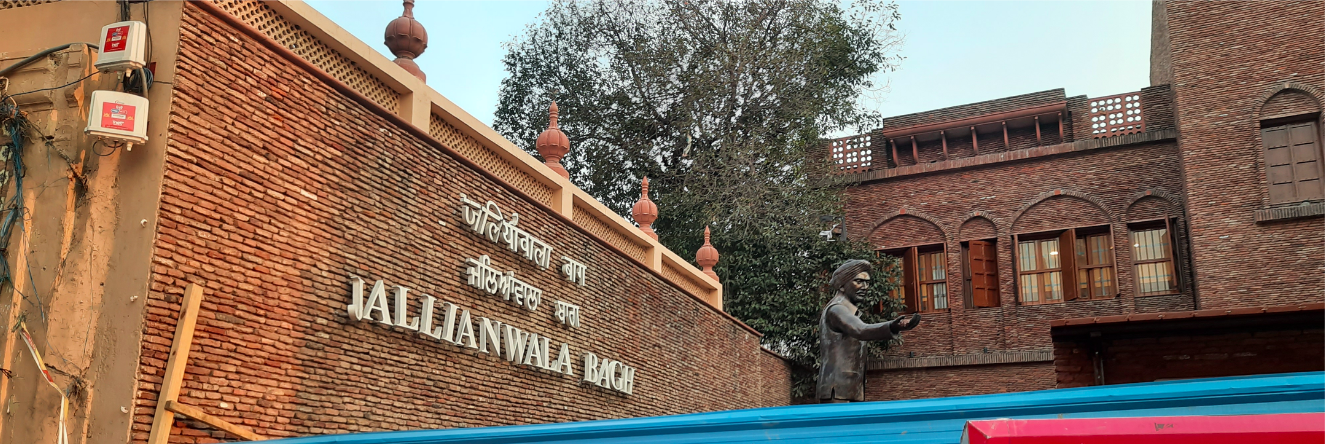
India has declared August 17 as Partition Remembrance Day. Painstakingly curated and mounted, the collection in the museum include photographs, digital prints of paintings and personal objects of use donated by refugees who came across the two borders. Some of these include a wooden chest, a nose ring or a part of fabric – shawl or sari – that they managed to salvage.
Testimonials from survivors who came in packed buses, trains, are the most painful to hear, drawing a tear or two. Many of them now old can be heard as saying how they lost members of their families in front of their eyes.
Newspaper headlines recording the period, numerous photographs, recording of speeches by politicians and freedom songs in addition to archival material are integrated. So are the events leading to the Partition, all of which are well documented. It has tried to include a number of voices – rich, poor, Dalits, and of course, Sindhis who too came across the western borders in droves to start anew in India. The last Gallery is named ‘Gallery of Hope’ wherein stories of co-operation and harmony between religious communities are urged as it pays a tribute to the resilience of the past generation and people’s hopes. The eastern side of the Partition is included and therefore, Bengali is included in the plaque though one feels more matter could have been added.
With a heavy heart but glad that such a memorial exists now for reminding us of the pain and suffering our previous generation went through, we look for a place to lunch. Not to forget the sacrifice the members of that generation made.
Breaking bread
Again we are looking for some more typical fare. Kesar da Dhaba turned out the best choice, not too far from the Heritage area but only after negotiating some serpentine alleys. Considered almost the oldest dhaba, (almost a hundred years!), the heaped plates of paratha roll off the waiters’ hands as quickly as they roll off your tongue. Punjab is, after all, known for a variety of breads – tandoori roti, naan, kulcha, bhatura and more.
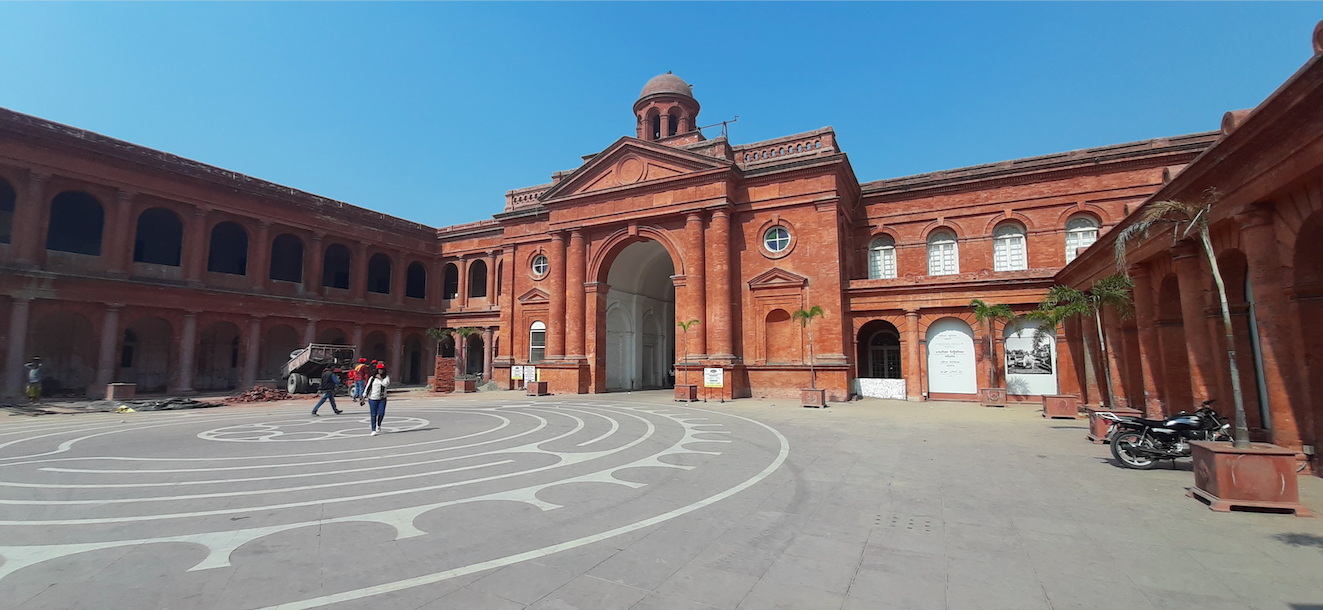
Served with kali dal, simmered over 12 hours on a low flame, and spicy sabzi, the parathas come in various flavours: alu, paneer, methi or plain. There are other types of bread as well. You can even try a thali complete with dal, sabzi, pickles and raita. The matka kulfi – kulfi served in a small matka (earthen pot) – is the perfect way to round off a meal at this dhaba.
After lunch, it is pack up time. There are many other sights of Amritsar, namely the Gobindgarh Fort and Maharaja Ranjit Singh Museum but we have a train to catch. There are modern amusement parks too. But our two-day trip captured the very essence of Amritsar full of polite and friendly people. On our way to the station, we pick up the typical sweet of the region – the dodhi, a sort of milk cake garnished with almonds. The pinni or the rich laddoo of the region is another delicacy, best had in cold winters. Made of desi ghee, wheat flour, jaggery or sugar, raisins and almonds, sometimes even urad dal is used. Most of the food we had at the small but very well-known eating joints had dishes that were mostly modestly priced, but not the sweets, which is sold by the weight.
As the train chugs out of Amritsar and makes its rhythmic journey back to Delhi, Rabindrrnath Tagore’s famous poem resonates in my ears. On the banks of the five rivers/ Uprise the Sikhs spontaneous/With hair coiled above their head/Inspired by the mantra their Guru spread/Fearless and unyielding.
(An excerpt from Rabindrantah Tagore’s poem: Bandi Bir or Captive Warrior. The electrifying lines bring back the days of Sikh uprising when Banda Singh Bahadur, a warrior and Guru Gobind Singh’s disciple and fellow Sikhs were tortured and ruthlessly killed by the Mughal rulers because they refused to convert to Islam.
Tales of a strong faith, heroism, bravery, fertile land and rich culture, I feel so happy and blessed to be born in this diverse country!
How to reach Amritsar
One can travel to Amritsar by air, road or railway from Delhi; and of course by a train or a flight from anywhere in India. The Shatabdi Express, of which there are several during the days of the week is by far the best way. Best time to visit is between November and March.

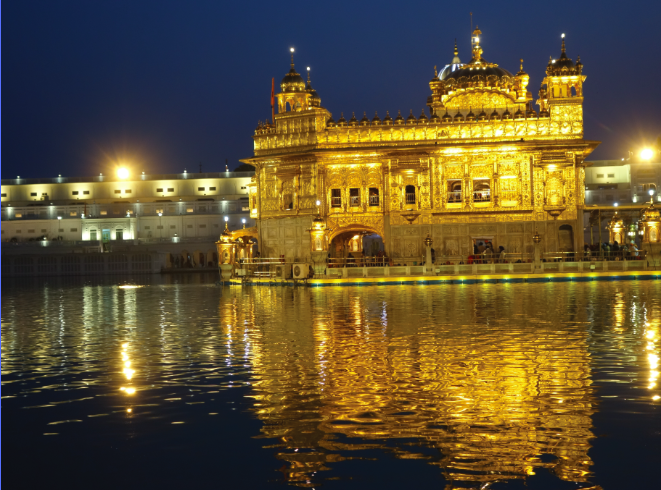
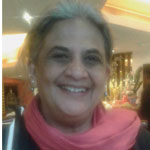 [/column]
[/column]